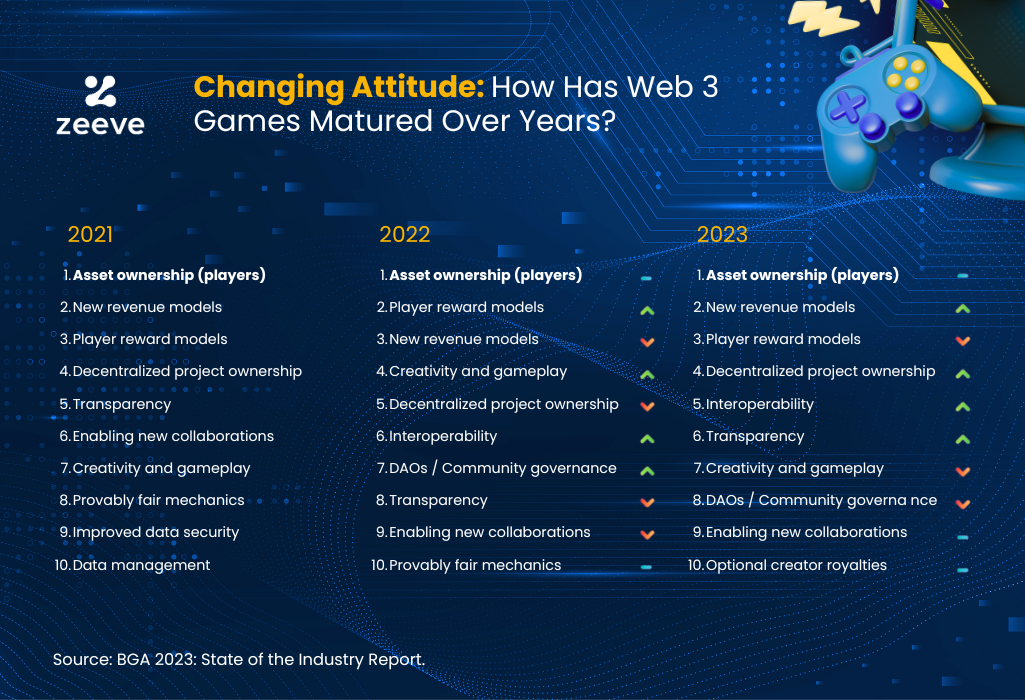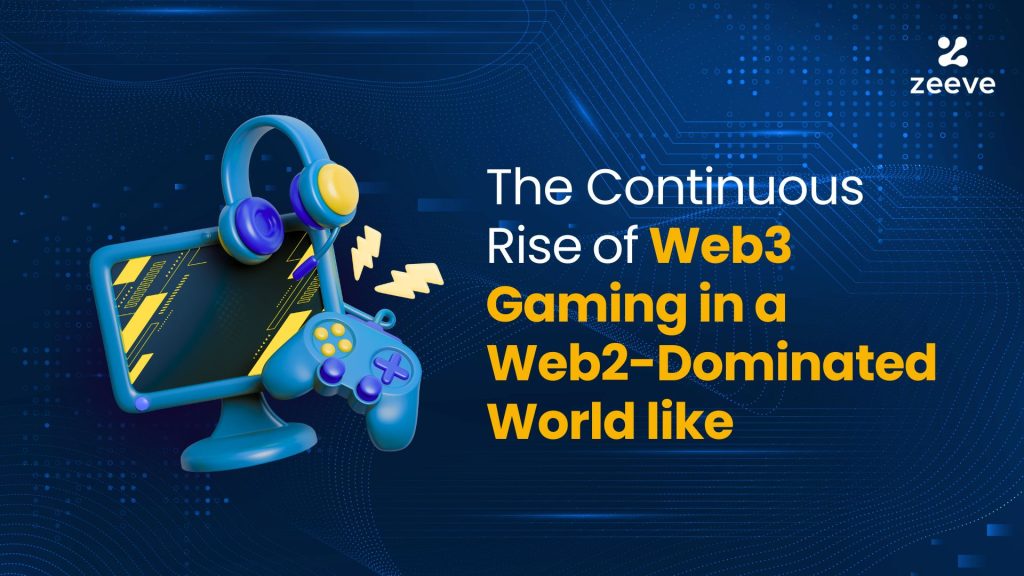BGA, or Blockchain Gaming Alliance, published a report for 2023 that discussed some key metrics that have changed over the years in blockchain-powered Web 3 games. In this article, we shall be closely analyzing how games have adapted to the changing trends allowing not only Web 3 games to evolve but also Web 2 games transition to Web 3 for competence and sustainability captivated by their dynamic evolution and innovations.
The 2021 Period: The Rise and Fall of New Web 3 Gaming Concepts
The 2021 period witnessed the explosion of Web3 games, with over 1.4 M UAWs or Unique Active Wallets created, triggered primarily by the Pandemic and new revenue models like Play-to-Earn (P2E). People were home-bound due to the CoronaVirus, and Web3 gaming ended up as a newfound treasure, riding on concepts like P2E models, where players were rewarded for performing activities in the game.
However, the momentum of P2E started to wither off when the bear market started, and tokens started losing their value. As per BGA or Blockchain Game Alliance report, while at the initial stages, some of the concepts of Web 3 games that revolved around asset ownership, revenue models, player reward model, and decentralized project ownership, transparency, new collaborations, creativity & gameplay created a FOMO. However, things started to go berserk when gamers eventually realized that a transition in Web 3 gaming experience shouldn’t be solely incentive driven; rather, experience is equally important. To prove this point, head of marketing at the Unix Games, Timothy Biggar says,
“The problem is, most gamers don’t care about earning potential. They just want to play the game. It’s our job to help developers build and market their games, so of course we’re paying attention to what’s working, for our partners and the industry, but we won’t know what works and what doesn’t until they’ve been on the market for some time. Ultimately, it needs to come down to your objectives as a blockchain developer.”
And whatever Timothy had said earlier started reflecting in games like Axie infinity, which started witnessing a dwindling interest of the gamers in its player reward model when Axie prices fell. And the domino effect was not restricted to only Axie infinity but it’s close counterparts, like Entropia, the game that introduced the concept of real gaming in the Metaverse with a lackluster attitude because decentralized ownership in the game went missing and the gaming ecosystem encountered instances of theft with a 265,000 PED or Project Entropia Dollars, which is equal to US$26,500 at the hands of either the publishers or hackers, also witnessed the same fate.
The remaining credibility of the P2E or earning models were compromised when games like HunterCoin and MotoCoin excessively started tapping only one segment, which is using incentivize as a bait to lure players.
However, over the period, that concept went non-sustainable and debatable for the growth of the gaming segment after the mention of Bots taking over and compromising the game mechanism, economies and leaving no room for gamers to stick with the P2E models, leading to a collapse of more than 1,000+ games from the market.
2022 Period: The Learning Curve
When the P2E model backfired with the likes of games like War Space featuring in the top 20 collections on Atomic Hub with a $6.2M sales volume, biting the dust. It was necessary to investigate the sharp drop of player’s interest. One might say that these games had community, new reward models and player’s interest intact; however, despite these trade-offs, why did they fail?
The game-play substance, missing in all these games. The learning was quickly deployed in games like Gods Unchained, which focussed at P2E initially, but later on pivoted to improving the game play through the launch of new attractive models like interoperable in-game asset ownership. It was soon followed by other games like Phantasma, which started improving specific features that allow in-game assets like pocket monsters in the Phantasma environment to be upgraded and made interoperable with other ecosystems to improve gameplay.
In addition to this, Phantasma went further ahead and introduced a dual token economy model as well in its gaming to further stimulate community participation of gamers looking for both gameplay and incentives. For that purpose, they introduced the SOUL and KCAL tokens, anchoring the narrative that only the revenue model will not be sufficient but an immersive game play is equally important.
Through the use of the SOUL Token, Phantasma not only bolstered the erstwhile revenue model but the ability to upgrade its game asset features further improved the game play mechanics to bind players to Web 3 gaming who were looking forward to transitioning from Web 2 games to Web 3 games.
2023 & Beyond: Embracing Innovations
In the year 2023, games had by now improved the P2E model and game-play to bind gamers and eventually new concepts like creator economy and e-sports started picking up pace.
However, the intriguing part to acknowledge in this period was the sudden transformation of Web3 games from a mere revenue-generating and game play platform for gamers/ecosystems to a comprehensive game experience hub spot.
How?
Games like My Pet Hooligan, illuvium, Star Atlas and Cross the Ages not only improved the gameplay mirroring the experience of top-notch games like Hearthstone, Legends of Runeterra, and Upland; but they also started exploring the elephant in the room, interoperability. Aurory, a free-to-play blockchain-based tactical Japanese game, has been the front runner in this category by not only improving the game play but also introducing cross-chain interoperability in gaming.
Due to this trade-off, the Web3 games, which have been criticized all these while for being an ecosystem embracing forced technical integration, started progressing towards solving the problems of Web 2 games, which have plagued their growth for years.
As a result, the swift growth and dynamic transformation that Web3 gaming withstood following multiple trials and errors have made them a force to be reckoned with while writing the script of a Web 2 to Web 3 transition and future of the game verse.

Final World
In the last three years, we have seen that Web 3 games deployed multiple models, some worked like improving game play mechanism, transparency , interoperability; while their other counterparts, like player reward models and DAOs, eventually failed
But that is not the end of the story for Web 3 gaming because we have barely scratched the surface of innovation for now. Some of the milestones like interoperability have been scaled and game play improved, the other things which soon emerge on the platter as Web 3 matures with time.
However, one thing to acknowledge nonetheless is the dynamic approach of Web 3 games in blending with the changing trends attracting some of the big names from the world of Web 2 games like Ubisoft, Square Enix, CCP, Nexon, Bandai Namco, Com2US, Sega, Konami, Atari, and NetMarble to move towards Web3 gaming to tackle their dropping revenue base and game participation. As a result, it is not an understatement to say that acknowledging the dramatic experimentation and adaptations, the future of Web 3 games is promising when games like Monsterarra, Game of Silk and Pirate Nation demonstrate innovation attracting more of Web 2 games to think for a Web 3 gaming transition.
Hence, in the near future, we might very well see Web 2 games adapting Web 3 models where they will not just get access to new revenue models, gameplay but also a one-chain ecosystem for all games. Such a trade-off could very well trigger new revenue models to emerge like special status for XP and powers in the game redeemable for utility tokens in a different game environment, speculative, not conclusive though.
Planning to build a game-specific rollup chain? Visit our gaming webpage to see what all benefits rollups can add to your application and how Zeeve can be helpful. Still have queries? Schedule a call with our Zeeve experts. We can help you figure our what infrastructure might suit your needs better.






